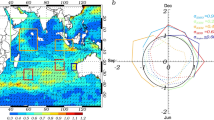Summary
The interannual variability of sea surface temperature (SST) anomalies in the tropical Indian Ocean is dominated mainly by a basin-scale mode (BM) and partly by an east–west contrast mode (zonal mode, ZM). The BM reflects the basin-scale warming or cooling and is highly correlated with El Nino with 3- to 6-month lags, while the ZM is marginally correlated with El Nino with 9-month lags.
During an El Nino, large-scale anomalous subsidence over the maritime continent occurs as a result of an eastward shift in the rising branch of the Walker circulation suppresses convection over the eastern Indian Ocean, allowing more solar radiation over the eastern Indian Ocean. At the same time, the anomalous southeasterly wind over the equatorial Indian Ocean forces the thermocline over the western Indian Ocean to deepen, especially in the southern part. As a result, SST over the whole basin increases. As El Nino decays, the subsidence over the maritime continent ceases and so does the anomalous southeasterly wind. However, the thermocline perturbation does not quickly shoal back to normal because of inertia and it disperses as Rossby waves. These Rossby waves are reflected back as an equatorial Kelvin wave, causing deepening of the thermocline in the eastern Indian Ocean, and preventing SSTs from cooling in that region. Moreover, the weaker wind speed of the monsoon circulation results in less latent heat loss, and thus warms the eastern Indian Ocean. These two processes therefore help to maintain warm SSTs over the eastern Indian Ocean until fall. During the fall, the warm SST over the eastern Indian Ocean and the cold SST over the western Indian Ocean are enhanced by air–sea interaction and the ZM returns. The ZM dissipates through the seasonal reversal of the monsoon atmospheric circulation and the boundary-reflected Kelvin wave. In the same manner, a basin-scale cooling in the tropical Indian Ocean can induce the ZM warming in the west and cooling in the east.
Similar content being viewed by others
Author information
Authors and Affiliations
Rights and permissions
About this article
Cite this article
An, SI. A dynamic link between the basin-scale and zonal modes in the Tropical Indian Ocean. Theor Appl Climatol 78, 203–215 (2004). https://doi.org/10.1007/s00704-003-0027-2
Received:
Revised:
Accepted:
Published:
Issue Date:
DOI: https://doi.org/10.1007/s00704-003-0027-2




